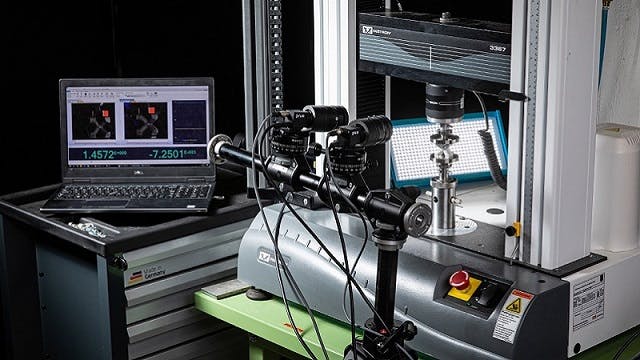More advanced materials such as composites are used in modern aircraft design for their lightweight properties. Characterizing the mechanical behavior of such complex materials and structures under load is a key enabler in optimizing aircraft designs and reaching the desired strength. One of the challenges of standard measurement techniques, though, is that they only provide limited and local information.
The fast development of digital camera technology in combination with high-performance digital image correlation (DIC) techniques is currently bringing a radical change in this domain and enabling a more efficient and more detailed characterization of materials and structures. DIC enables the identification of mechanical properties of materials by measuring displacement and strain of material samples on dedicated testing machines.
This solution fits into verification processes that need to run when new materials are being considered for aircraft. The Simcenter digital image correlation capabilities support in that context the verification management digital thread within the Siemens Xcelerator portfolio.
In this webinar, we address the following topics for simulation and testing teams:
- Instrumentation and full-field measurement process
- Materials testing and identification
- Structural testing and structural dynamics testing
- Digital twin validation processes
Benefits of digital image correlation in aviation
Thanks to DIC, it is now possible to extract full-field 3D geometry, displacement, strain and acceleration under any load and for almost any type of aircraft material, with limited instrumentation. These data are crucial in the materials engineering process, as they allow identifying material properties, validating numerical models and assessing the strength of materials and components without the risk of overlooking key local phenomena.
The technology is also applicable to analyze aircraft structural vibrations and dynamic responses. It can be used to characterize rotating and lightweight structures that would otherwise be extremely difficult to test with standard techniques.
Why is digital image correlation important?
Digital image correlation is important to manage increasing complexity in aircraft materials and structures. New issues related to composites, superalloy, lattice structures and more are adding to the complexity. There is a need for faster and more accurate design and verification techniques. DIC provides a new paradigm in materials and structural testing.
How is digital image correlation used in aerospace?
We explain how DIC is used in aerospace, discussing its main applications:
- Materials testing and identification (coupon test)
- (Quasi) Static and dynamic testing of structures
- How to use full-field measurement data to validate a digital twin
Watch the video to learn more.
Meet the speakers

Raphael Hallez
Aerospace Business Development Manager, Simcenter Testing Solutions
With nearly 20 years at Siemens Digital Industries Software, Raphael has been involved in many testing and simulation projects for aviation, space and defense companies. He is currently in charge of the business development activities for the Simcenter testing solutions.

Stéphanie Duchesne Sailly, PhD
CEO
After 20 years spent in the world of testing and simulation, Stéphanie created MECATEST to promote the link between physical testing and digital simulation. With her experience acquired at MTS Systems, Hexagon MSC Software, and with numerous automotive stakeholders, she facilitates the use of digital image correlation in various industries.



